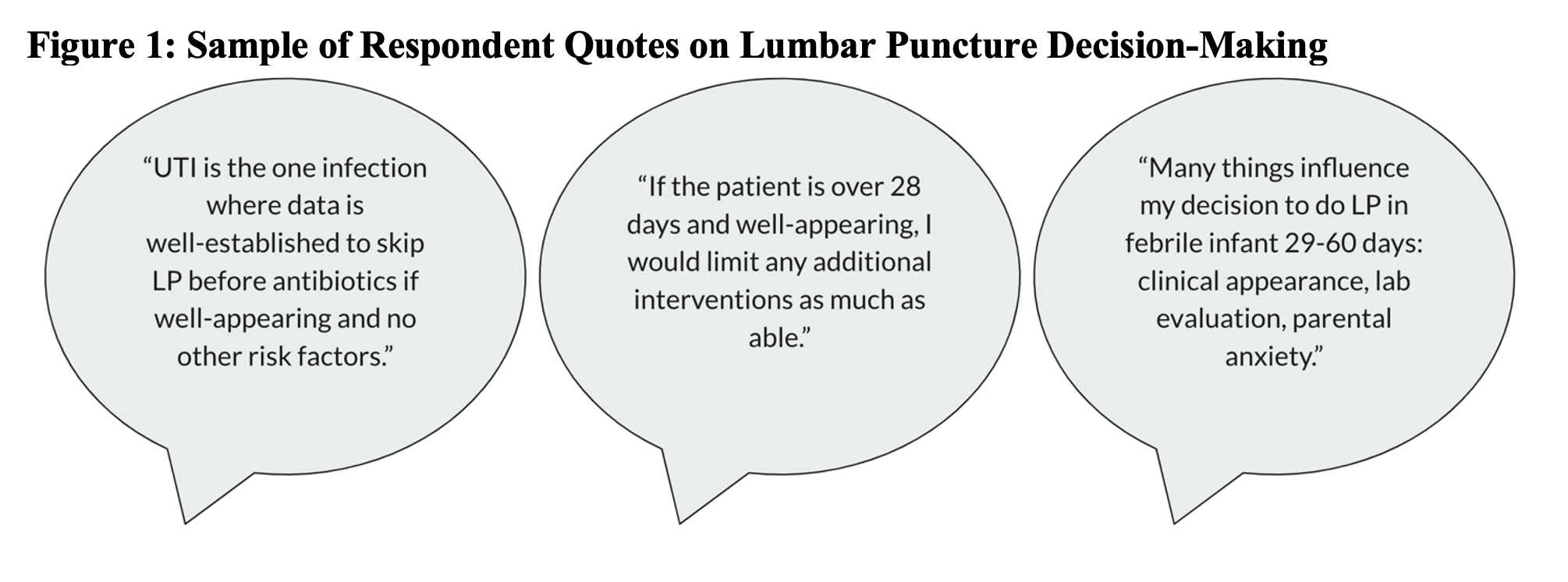Neonatal General
Neonatal General 5: COVID, Infections Diseases
704 - Clinician Perspective on Factors Influencing Lumbar Puncture in Febrile, Well-Appearing Infants 29-60 Days Old
Publication Number: 704.233

Jeremiah Lowe, MD, MSc (he/him/his)
Resident
University of Colorado and Children's Hospital Colorado
Denver, Colorado, United States
Presenting Author(s)
Background: Historically, guidelines have been ambiguous regarding when to obtain lumbar punctures (LP) in febrile but otherwise well-appearing neonates aged 29-60 days. New American Academy of Pediatrics (AAP) guidelines aim to clarify recommendations but may not yet be widely adopted.
Objective: This study sought to evaluate clinician perspective on factors that influence the decision to obtain LPs in febrile, well-appearing neonates aged 29-60 days.
Design/Methods:
A web-based survey with multiple-choice and free response questions was distributed to providers at an academic-affiliated, quaternary care children’s hospital. The survey queried factors that influence the decision to obtain LP in this population, in particular, clinical risk factors used in AAP and institutional guidelines. We used ANOVA and chi-squared analyses to evaluate whether influencing factors differed by provider characteristics (role, years since training, practice setting).
Results:
There were 142 responses (response rate 26%) from a variety of providers (Table 1). 92% of respondents do not routinely obtain LPs in this population. Table 2 summarizes factors on a Likert scale from 1 (does not influence one to obtain LP) to 5 (strongly influences). Respondents were minimally influenced by practical barriers of cost or staffing concerns. Positive influences included clinically documented fever, absence of respiratory viral infection symptoms, younger age, prematurity, and maternal Group B Streptococcus. Elevated procalcitonin, particularly when >1.71, was the strongest influencing factor surveyed. If planning to start antibiotics for urinary tract infection (UTI), 65% would still obtain an LP. Comparative analysis demonstrated that recent graduates (≤10 years) were significantly more influenced by moderately elevated procalcitonin (0.3-1.71) compared to those who graduated >10 years ago (p=0.04). ED providers were more likely than hospital medicine, ICU, and others to be influenced by moderately elevated procalcitonin and white blood cell count outside the reference range (p< 0.001 and p=0.005, respectively). Respondents voiced opinions highlighting subjectivity in decision-making (Figure 1).
Conclusion(s): In accordance with the current AAP guidelines, few providers perform LP on all well-appearing febrile infants aged 29-60 days. Most respondents favored LP even in the presence of UTI, suggesting slower adoption of this aspect of the guideline. Among surveyed risk factors for meningitis, elevated procalcitonin emerged as a point of consensus with the greatest influence towards LP.
.png)
.png)
